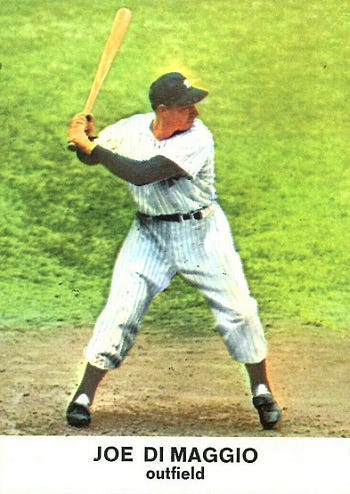Note: When you click on links to various merchants in this newsletter and make a purchase, this can result in this newsletter earning a commission. Affiliate programs and affiliations include, but are not limited to, the eBay Partner Network and Amazon Associates.
1961 Fleer Joe Kuhel (#119) - Card of the Day
Baseball history is rife with players who took on an unflappable, larger-than-life, movie-star persona by virtue of their station in life (on the diamond) and the way they held themselves and adorned themselves in the public eye.
Guys like Mark Lee, for example:
Why, your eyes can hardly even focus on this card, so strong is the swagger. And with those flowing locks, that tickle-his-nostrils ‘stache, and those tinted Coke bottles, Lee is practically the definition of Joe Cool on his 1979 Topps rookie card (#138).
Of course, some guys don’t have to work quite so hard to be groovy. Some guys don’t have to brag or primp or grow into their ease with the world. Some just seem to have “it” from the cradle.
You know the guys, the ones who are practically born as Joe Cool.
But did you know about the one who was actually born as Joe Kuhel?
That would be one Joseph Anthony Kuhel, born and raised in Cleveland. His rearing and schooling led him on a winding path to the majors that all started when he left high school after one year to become a leather cutter.
In his off hours during the warm weather, Cool Kuhel played in various local leagues, manning first base and hitting with left-handed authority. He eventually caught the eye of pro teams, beginning with the Class-B Flint Vehicles in 1924.
From there, it was a long six-year drive through the minors, eventually landing Kuhel on the doorstep of Griffith Stadium in Washington, D.C. After debuting with the Senators on July 31, 1930, Kuhel played in 18 games, mostly in August.
Then, the next summer, he supplanted Joe Judge as manager Walter Johnson’s starting first baseman. Kuhel held onto the job, mostly uninterrupted, until the Senators traded him to the White Sox for Zeke Bonura in March of 1938.
First base in Comiskey Park was the Kuhel Korner for the next six seasons, and then Washington bought his contract back in November of 1943. There he stayed for his age-38 and age-39 seasons before the Senators released him during the 1946 season. The White Sox then brought him back, too, and he stayed there through June of 1947.
That brought his big league playing career to an end, and it was a fairly distinguished one, number-wise, for a guy who doesn’t get much play in conversations today — 2212 hits, 131 HR, 1049 RBI, 1236 runs scored, 178 stolen bases, .277 BA/.359 OBP/.406 SLG.
All of that came too early in hobby history for Kuhel to land a real, live career-capper card, but Fleer included him in their 154-card Baseball Greats set in 1961.
You can see the front of that one at the top of this post, and the back did indeed cap things nicely:
Kuhel also received MVP votes five times, finishing as high as sixth in 1936.
Well before Fleer tagged him for cardboard immortality, and after most of a year out of the majors, Kuhel was back in Washington one more time in 1948 — as Senators manager.
Two seasons in the hot seat produced a pretty typical Senators result, with Kuhel’s teams going a combined 106-201 and finishing seventh and eighth in the American League. That would be that for Kuhel in the majors, but he did manage the Kansas City Blues, the Yankees’ American Association team, in 1950.
He must have found at least the locale to his liking, because Kuhel stayed in K.C. and forged a long career in sales.
And today is a better day than most to celebrate Joe Cool Kuhel, who was born on June 25, 1906.
1961 Golden Press Joe DiMaggio Got in on the Act
When Kuhel finished sixth in 1936 A.L. MVP voting, he landed a scant one point ahead of rookie Joe DiMaggio. The two crossed paths again, sort of and in a hobby sense, in 1961.
Kuhel, of course, was part of the Fleer set that year (see “Card of the Day” above). DiMaggio, meanwhile, was one of 34 cards in the 1961 Golden Press set, along with teammate and MVP winner Lou Gehrig.
You can see that Joltin’ Joe card directly above and read more about it right here.







